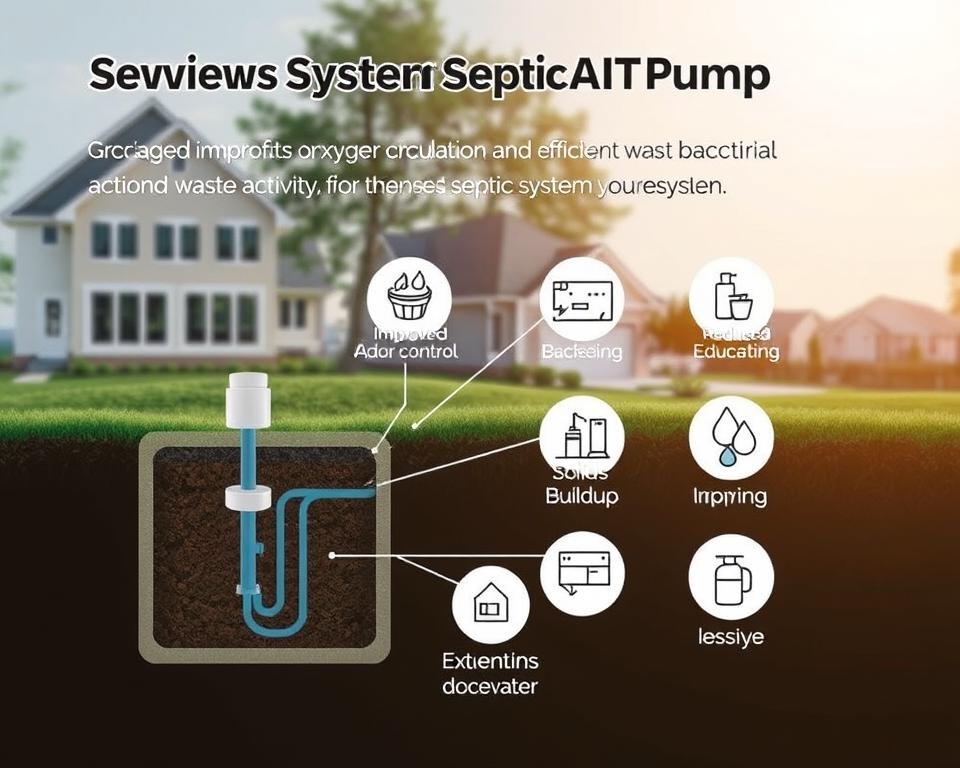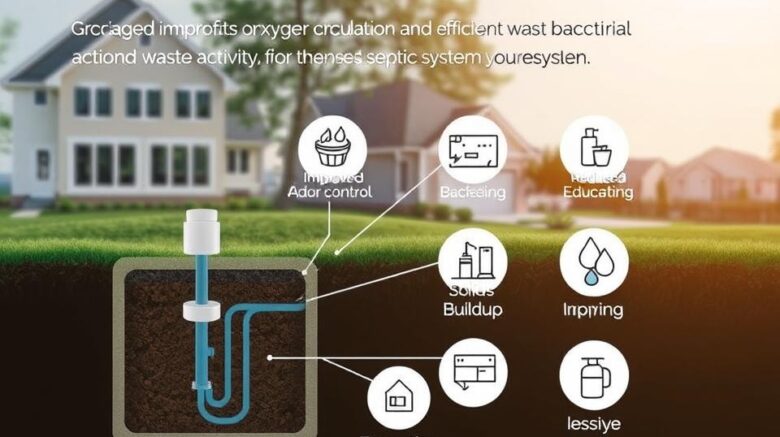Aerobic Tank Air Pump: Must-Read Guide for Homeowners
Ever pondered on what powers your aerobic septic system’s performance? The Septic tank aerator is the unsung key component vital for your system. In this article, you will get essential information on the air Pump’s function. It’s necessary for a sound, efficient Septic tank.
Grasping the importance of a Septic tank air Pump can boost your Septic system’s operation using septic pumping companies near me. It also safeguards your asset value and local environment. Our handbook will present All in Sanitation, a well-regarded Septic industry specialist. They’re equipped to serve your Septic aerator Pump needs.
Main Points
- The Septic air Pump is indispensable for air-driven Septic tanks.
- Servicing your Septic system air Pump can optimize overall system function.
- Periodic reviews extend the lifespan of your Septic tank air Pump.
- Selecting the right Septic aerator Pump is critical for top operation.
- All in Sanitation offers dedicated services for Septic air Pump support.
Getting to Know Aerobic Septic Setups
Aerobic Septic systems provide a superior waste treatment alternative by utilizing oxygen. This method relies on aerobic bacteria flourishing in well-oxygenated environments. These bacteria are better in decomposing organic matter. With the help of Septic aerator Pumps, these systems provide a constant oxygen supply, boosting the waste decomposition process.
These systems perform well in decreasing sludge buildup, due to the activity of aerobic bacteria. This reduction in solid waste means minimal cleaning and Pumping is required less often. Additionally, they efficiently treat wastewater, leading to barely any odor. This creates a improved environment for homeowners and the community together.
To confirm these systems function smoothly, it’s necessary to know the key Septic system components. These include the Septic tank, aeration chamber, and effluent Pump. Each part plays an important part, especially the air Pump. It injects oxygen into the tank, crucial for the aerobic bacteria’s effectiveness.
Value of the Septic Air Pump
The Septic air Pump is key in the performance of aerobic Septic systems. It acts as the system’s “lungs,” providing the needed oxygen mandatory. This oxygen permits aerobic bacteria to thrive and decompose waste properly. If the Pump breaks, the system’s effectiveness decreases, causing sludge collection and possible odors.
Such issues can interfere with Septic system operations and create environmental hazards. By recognizing how vital the Septic air Pump is, homeowners can take proactive steps. They can secure its optimal function through consistent upkeep. This prevents failures, avoids costly repairs, and keeps the aerobic system’s condition.
Major Benefits of Using a Septic Air Pump
Running a Septic air Pump markedly increases the efficiency of Septic systems. Septic air Pumps are key as they quicken the breakdown of waste. This is accomplished by oxygenating the treatment process, supporting aerobic bacteria growth. These bacteria are necessary for proper waste treatment.
They’re also useful in minimizing foul smells. Because of more active aerobic processes, waste is processed faster, thus diminishing odors. This makes the environment more pleasant for homeowners.
Another valuable benefit is the reduction in sludge buildup. Consequently, tanks necessitate less frequent Pumping, reducing both money and time. Better processing not only reduces spending but also prolongs the lifespan of the drain field.
Looking after these Pumps well means less frequent repair costs and satisfying regulatory standards. Thus, the pluses of Septic air Pumps go beyond being for homeowners. They also enhance environmental health by raising waste management practices.
| Benefit | Description |
|---|---|
| Fast Waste Breakdown | Heightened aerobic activity quickens the decomposition process. |
| Minimized Odor Emissions | Optimized treatment efficacy results in fewer odors. |
| Reduced Sludge Buildup | Minimal Pumping and maintenance are necessary. |
| Extended Drain Field Life | Better treatment ensures a healthier drain field. |
| Cost Savings | Lower probability of repairs and regulatory compliance cost. |

Finding a Suitable Septic Air Pump
Selecting the right Septic air Pump is vital for an optimized aerobic system. Homeowners should assess various factors for the ideal match. The size of the tank and the airflow needs matter greatly the Pump’s effectiveness.
To make an informed choice, it’s essential to recognize the air Pumps available. There are mainly two types: diaphragm Pumps and rotary vane Pumps. Each delivers unique benefits, which should be paired with your home’s unique requirements and operational profile.
Energy use also matters. Opting for a Pump that cuts energy use while delivering the needed airflow can result in meaningful reductions. Assistance from All in Sanitation experts can be priceless. They confirm the Pump you choose meets your system’s requirements seamlessly.
Popular Categories of Septic Air Pumps
Homeowners can decide more effectively by knowing the multiple Septic air Pumps available. There are mainly two types: diaphragm Pumps and rotary vane Pumps. Each has its particular functions and benefits.
Diaphragm Pumps, noted for their hushed operation, are preferred for residential Septic systems. They offer energy efficiency while providing steady air flow. Their constant performance fits smaller systems, meeting the needs of many homeowners.
Rotary vane Pumps, however, are ideal for higher-capacity or commercial systems. These Pumps offer greater output, required when handling bigger loads. Their strong build allows efficient operation in heavy-duty Septic systems.
| Type of Pump | Best Use | Advantages |
|---|---|---|
| Diaphragm Pumps | Residential Systems | Quiet operation, energy-efficient, reliable air flow |
| Rotary Vane Pumps | Larger or Commercial Systems | Powerful performance, high capacity, durable construction |
Recognizing the contrasts in Septic air Pumps is important for upgrades or replacements. Each Pump type provides unique qualities to satisfy various needs. This guarantees best performance for any system.
Indicators You Require a Septic Air Pump Replacement
Homeowners must look out for Pump failure signs in their Septic systems. Some indicators suggest the need for a Septic air Pump replacement. These ensure continued performance. Catching these early avoids major issues.
Signs of potential problems include:
- Unusual noises from the Pump, like grinding or buzzing, might suggest internal damage.
- A clear lack of air output reveals the Pump isn’t performing as intended, reducing efficiency.
- Repeated electrical problems, such as tripped breakers or power dips, could point to overloading.
- Visible damage on the Pump unit, with cracks or leaks, requires quick action.
- Unpleasant odors in the yard often indicate a compromised Pump, showing ineffective effluent aeration.
Spotting these signs early prevents costly fixes or total system failure. Scheduling regular checks helps spot these issues. It also shows if you require a new Septic air Pump.
Maintenance Tips for Your Septic Air Pump
For an well-running Septic air Pump, routine upkeep is essential. This ensures that that your system operates correctly. Homeowners can apply several simple care strategies for maximum results.
Twice a year, perform a detailed inspection for wear or damage. It is also necessary to change the filters as recommended. This prevents clogs that could reduce efficiency.
The Pump should be placed on a firm base to lessen vibrations, which could harm it over time. A protective cover is vital too. It protects against debris and water, sustaining the Pump’s functionality.
Regular servicing can greatly prolong the life of your Pump. In turn, this benefits the Septic system’s performance overall.
| Maintenance Task | Frequency | Benefits |
|---|---|---|
| Inspect Pump for damage | Every 6 months | Identifies issues early |
| Replace filters | As needed | Improves efficiency |
| Check surface stability | Annually | Limits wear |
| Clear debris around Pump | Monthly | Prevents clogs |
Setting Up Your Septic Air Pump
Proper installation of your Septic air Pump is key for its optimal operation. To start, select a reliable, moisture-free area for placement. The chosen spot should firmly bear the Pump’s weight with ease.
To successfully mount your Pump on your own, follow the following guidelines:
- Collect all necessary items, including the Pump, a power source, and hose fittings.
- Check the manufacturer’s guidelines before starting your installation.
- Confirm every connection is tight to stop air leaks that hurt performance.
- After assembly, run a test to verify the system works as intended.
If the installation process appears difficult, reach out to All in Sanitation. Their professionals can sidestep common errors, making sure your setup meets necessary safety requirements.
Advantages of Using All in Sanitation for Your Septic Air Pump Services
When choosing a Septic service provider, the choice is key. All in Sanitation distinguishes itself by supplying dependable Septic air Pumps. They address wide-ranging homeowner requirements with a extensive selection of high-grade products. This ensures customers secure an exact match for their Septic systems.
What further defines All in Sanitation is not solely their large product lineup. Their devotion to excellent customer service is also critical. Homeowners receive knowledgeable support, helping them choose trusted Septic solutions. This partnership is essential to tailor each solution to meet specific needs.
All in Sanitation also focuses on aftercare to ensure lasting satisfaction. Their devotion goes beyond the initial sale. They offer ongoing support to keep Septic systems operating efficiently for the long haul.
Expense Overview for Septic Air Pumps
Understanding the financial elements associated with Septic air Pumps is key for homeowners who run aerobic Septic systems. Initially, one faces the price tag, which includes the Pump and associated accessories. Installation expenses differ, according to the system’s complexity and any changes required.
Ongoing upkeep forms an additional cost layer. Regular inspections can ward off bigger issues, which can mean savings. Homeowners should plan for Septic maintenance to retain the Pump’s effectiveness and service life. Such planning avoids expensive repairs later on, showing the benefit of proactive maintenance.
| Cost Component | Average Cost Range |
|---|---|
| Septic Air Pump | $500 – $1,200 |
| Installation | $300 – $800 |
| Annual Maintenance | $150 – $400 |
| Potential Repair Costs | $1,000 – $5,000 |
Separating Septic air Pump expenses into distinct parts assists homeowners in cost forecasting. This detailed approach provides the system’s smooth operation and their comfort.
The Bottom Line
For homeowners with aerobic Septic systems, maintaining Septic setups is vital. The proper Septic air Pump improves waste processing and prolongs your system’s life. Committing to consistent service and promptly addressing issues stops high expenses and disruptions.
Selecting a Septic air Pump calls for attention. This guide covered how to choose wisely about installation and replacement. With All in Sanitation’s expertise, you can manage your Septic systems’ complexities with confidence.
Maintaining your Septic air Pump enhances your system’s operation and life span. It provides a trouble-free and effective operation over time. Keep in mind, your home’s wastewater management is strongly influenced by consistent upkeep.
